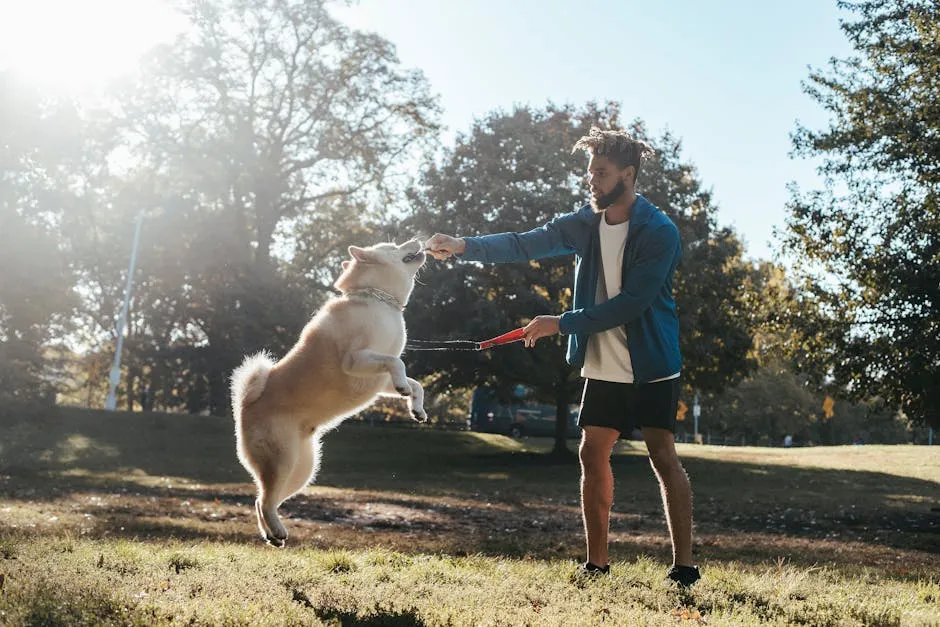Introduction
Have you ever looked at your dog and wondered just how old they really are? Welcome to the puzzling world of dog years versus human years! Many folks believe that one dog year equals seven human years. While this catchy phrase rolls off the tongue, it’s more of a myth than a truth. In reality, dogs age at a much more complex pace, especially in their early years.
Picture a puppy bursting with energy, playing like there’s no tomorrow. That first year of their life equates to around 15 human years! Yes, that’s right! By the time your pup hits their second birthday, they’re already equivalent to a sprightly 24-year-old in human terms. As a dog owner, understanding how your furry friend ages can help you provide the best care possible.
Curiously, lifespans can vary dramatically across different breeds. Smaller breeds, like Chihuahuas, tend to live longer, often into their late teens. In contrast, larger breeds, such as Great Danes, typically only have a lifespan of 8 to 10 years. So, how do we accurately calculate a dog’s age? Fear not! There are more precise methods than just the classic 1:7 ratio.
Let’s lighten the mood with a little comparison: Think of your dog as a 5-year-old child who just learned to ride a bike. They’re fearless, racing around the park, while you’re left in the dust, panting behind them. As they age, they might transition into a laid-back teenager, lounging around the house. Eventually, they turn into a wise old soul, like your favorite grandparent, who just wants to cuddle on the couch. Understanding these stages can help you appreciate your dog’s journey through life even more.

Speaking of providing the best care, consider investing in high-quality dog food to ensure your furry friend gets the nutrients they need. Check out this high-quality dog food that can help keep your dog healthy and happy!
Calculating Dog Years to Human Years
Methods to Calculate Dog Age
How do we convert those adorable canine years into human terms? The traditional method, which states that one dog year equals seven human years, has been debunked. Turns out, this catchy phrase doesn’t quite cut it! Dogs mature much faster in their early years. The first year of a dog’s life is roughly equivalent to 15 human years. By the age of two, they’re already about 24 in human years. After that, each additional year is roughly 4 to 5 human years, depending on the size and breed of the dog.
Recent research from the University of California San Diego introduced a more scientific formula: Human Age = 16 * ln(Dog Age) + 31. This method accounts for biological changes over time, giving a more accurate portrayal of your pooch’s age.
To simplify things, here’s a handy age chart that breaks down how small, medium, and large dogs age:
| Dog Age (Years) | Small (Under 20 lbs) | Medium (20-50 lbs) | Large (50-100 lbs) | Giant (Over 100 lbs) |
|---|---|---|---|---|
| 1 | 15 | 15 | 15 | 12 |
| 2 | 24 | 24 | 24 | 22 |
| 3 | 28 | 28 | 30 | 32 |
| 4 | 32 | 32 | 35 | 37 |
| 5 | 36 | 36 | 40 | 42 |
| 6 | 40 | 42 | 45 | 49 |
| 7 | 44 | 47 | 50 | 56 |
| 8 | 48 | 51 | 55 | 64 |
| 9 | 52 | 56 | 61 | 71 |
| 10 | 56 | 60 | 66 | 78 |
| 11 | 60 | 65 | 72 | 86 |
| 12 | 64 | 69 | 77 | 93 |
| 13 | 68 | 74 | 82 | 100 |
| 14 | 72 | 78 | 88 | 107 |
| 15 | 76 | 83 | 93 | 114 |
| 16 | 80 | 87 | 99 | 121 |
This chart serves as a quick reference to help pet owners understand how their furry friends age in human years.

Dog Size Categories
Understanding dog size categories is essential when calculating age. Here’s a simple breakdown:
– Small Dogs: Typically weigh under 20 pounds. They tend to mature slower and live longer, often not reaching senior status until around 10 years. To learn more about creating a safe environment for these small breeds, check out this article on How to create a safe play area for small dogs.
– Medium Dogs: Weigh between 21 to 50 pounds. They usually become seniors around the age of 7. If you have a medium-sized dog, consider a comfortable orthopedic dog bed to support their joints as they age!
– Large Dogs: Weigh between 51 to 100 pounds. These pups age faster and often enter their senior years around 5 to 6 years of age.
– Giant Dogs: Weigh over 100 pounds. They are considered seniors by the time they hit 6 or 7 years.
The size of your dog directly influences its aging process and overall health. Bigger dogs may show age-related health issues earlier than smaller breeds. To help with joint health, explore joint health supplements that can work wonders for your aging dog!

Age Conversion Examples
Let’s put this into practice! If your dog is 3 years old and weighs 30 pounds (medium size), they would be approximately 28 in human years. A 5-year-old large breed dog would convert to about 40 human years.
Now, let’s take a giant breed. If you have a 10-year-old Great Dane, their human equivalent age is roughly 78 years!
These examples illustrate how crucial it is to understand your dog’s age accurately. This knowledge helps you monitor their health and provide appropriate care as they transition into their golden years.

By grasping these calculations and their implications, you can be a more informed and caring pet parent, ensuring your dog leads a happy and healthy life!
Factors Influencing Lifespan
Breed and Size
When it comes to determining how long our furry pals will stick around, breed and size are the heavyweights! Different breeds have different lifespans for a variety of reasons. Small breeds, like Chihuahuas, can live up to 15 years or more, while larger breeds such as Great Danes often have lifespans around 8 to 10 years. Why the difference? Well, larger dogs tend to age faster and face more health issues.
Statistics show that small dogs live, on average, about 12 to 16 years, while medium breeds typically live about 10 to 13 years. Larger dogs? They usually clock in at around 9 to 12 years. It’s all tied to their growth rate and metabolism. Larger dogs grow rapidly, but this rapid growth can lead to earlier aging. On the flip side, smaller dogs mature slower, which may contribute to their longer lives. Genetics also plays a role; some breeds are simply predisposed to certain health conditions, which can impact overall longevity.

Health and Lifestyle Choices
Now that we’ve covered breed and size, let’s talk health! A dog’s diet, exercise, and regular vet visits are paramount. Just like humans, a balanced diet is crucial. High-quality dog food ensures pups get the right nutrients to thrive. Poor nutrition can lead to obesity, which is linked to a slew of health issues, including diabetes and joint problems. For senior dogs, it’s especially important to choose the right food. Check out this guide on choosing the right dog food for senior dogs.
Exercise is non-negotiable! Regular activity helps maintain a healthy weight and keeps the heart pumping. Think of it as a doggie version of hitting the gym. On top of that, routine veterinary care is essential. Regular check-ups can catch health issues early, making treatment easier and more effective. Preventive care, like vaccinations and dental cleanings, can enhance a dog’s quality of life and extend their time with you. Remember, a healthy dog is a happy dog!

And speaking of keeping your dog healthy, have you considered a dog grooming kit? Regular grooming not only keeps your pup looking sharp but also helps you monitor their skin and coat health.
Signs of Aging in Dogs
As our furry friends grow older, they start showing signs of aging. Look out for the following physical and behavioral changes:
– Cloudy eyes or vision issues
– Graying fur, especially around the muzzle
– Stiff joints or difficulty getting up
– Weight changes, whether gain or loss
– Behavioral shifts, like increased anxiety or confusion
– Changes in sleep patterns

Monitoring these signs is vital! Keep a close eye on your dog as they hit middle age (around 5-7 years for large breeds and 7-10 for small breeds). If you notice any concerning changes, it’s time to consult your vet. Early intervention can make a world of difference in maintaining your dog’s health and happiness.
Being proactive about your dog’s aging process can lead to a longer, healthier relationship. Understanding these signs will help you provide the best care possible as they transition into their golden years. After all, every wag of that tail counts!
Importance of Knowing Your Dog’s Age
Understanding your dog’s age is more than just a fun trivia question at a dog park. It’s crucial for their health and well-being. Knowing their age helps you tailor their care to meet specific needs. Just like humans, as dogs age, they undergo significant physical and mental changes.
First and foremost, understanding your pup’s age can help you monitor their health. Dogs age differently based on their size and breed, meaning that a small breed might be considered a senior at around ten years, while a large breed may hit that status at five. This distinction is vital. Knowing when your dog transitions into their senior years enables you to adjust their diet, exercise routines, and healthcare accordingly.

For instance, senior dogs may require easier-to-digest food and more frequent veterinary check-ups. These visits can catch potential health issues early, which is essential for maintaining your dog’s quality of life. Dogs age rapidly in their early years, so understanding where your furry friend stands on that timeline can help ensure they get the right care at the right time.
Moreover, recognizing the signs of aging can lead to better emotional support for your dog. As they transition into their golden years, dogs may experience anxiety or changes in behavior. If you know your dog’s age, you can better interpret these changes, providing comfort and reassurance when they need it most.
Lastly, acknowledging your dog’s age fosters a deeper bond between you and your furry friend. Every moment spent together matters, and understanding their life stages allows you to appreciate the time you have left with them. Just like a family member, your dog deserves the best care possible, tailored to their unique age and needs.
In short, knowing your dog’s age is essential for optimal care and companionship. It allows you to provide a loving and supportive environment, ensuring your canine buddy lives a happy, healthy life for as long as possible.
How to Help Your Dog Live Longer
If you want your furry friend to stick around for many tail-wagging years, there are several simple steps you can take! Let’s break down some practical tips for promoting longevity in dogs.

First off, consider their diet. High-quality dog food is a must! Look for brands that meet AAFCO standards, ensuring your pup gets all the essential nutrients they need. A balanced diet helps maintain a healthy weight, which is crucial. Obesity is linked to various health issues, including diabetes and joint problems. Consult your vet for advice on portion sizes and suitable foods for your dog’s breed and age. For more details on canine nutrition, see this article on Understanding canine nutrition: raw vs. kibble debate.
Next up, exercise! Regular physical activity is vital for your dog’s health. Aim for daily walks, playtime, and mental stimulation. Activities like fetch or agility training can keep them engaged and fit. Remember, a tired dog is a happy dog!
Don’t forget regular vet check-ups and vaccinations. Routine visits help catch health issues early, making treatment easier. Keep vaccinations up to date, especially for widely communicable diseases. This proactive approach ensures your dog stays healthy and protected.
Mental stimulation is just as important as physical exercise. Engage your dog in activities that challenge their mind, like puzzle toys or obedience training. Socialization is also key. Exposing your dog to different environments, people, and other pets helps reduce anxiety and fear.
Lastly, give your dog love and attention. A strong bond with their human can enhance their emotional well-being. Spend quality time together, whether it’s snuggling on the couch or going on adventures.
By following these simple guidelines, you can help your dog live a longer, happier life. After all, every extra moment with your furry friend is a treasure!
Conclusion
Understanding how to calculate dog years accurately is essential for every dog owner. The myth of one dog year equaling seven human years simplifies a complex reality. Dogs age at different rates based on their size, breed, and overall health. By grasping these nuances, you can foster a loving and healthy environment for your furry friend.
This knowledge enables you to tailor your dog’s care to their specific needs. For instance, older dogs may require special diets, more frequent vet visits, or gentle exercise routines. Being aware of their age and corresponding needs can significantly enhance their quality of life, ensuring they feel loved and well-cared for.

So, as you cuddle with your pup or embark on a walk, remember to cherish every tail wag and joyful bark. Your dog, regardless of their age, is a treasure, deserving of all the love and attention you can provide. After all, the moments you share with them are what truly count, transforming the years into cherished memories, no matter if your companion is a sprightly puppy or a wise old friend.
FAQs
How old is a 7-year-old dog in human years?
A 7-year-old medium-sized dog is approximately 47 in human years. For small breeds, it might be around 44, while large breeds could be closer to 50. This variation highlights the importance of size in determining age equivalence.
What are the oldest dog breeds?
Some of the oldest dog breeds include the Basenji, Saluki, and Afghan Hound. These breeds have histories that date back thousands of years, making them some of the most ancient companions known to humans.
Why do smaller dogs tend to live longer?
Smaller dogs often live longer than larger ones due to their slower metabolism and lower susceptibility to certain diseases. Their bodies face less strain compared to larger breeds, leading to a longer lifespan on average.
How can I estimate my dog’s age if I don’t know it?
You can estimate your dog’s age by examining their teeth, coat condition, and overall health. Puppies have baby teeth, while adult dogs show wear and tartar buildup. Additionally, consulting a veterinarian can provide a more accurate estimate based on physical examination.
What are common health issues for older dogs?
Older dogs may face various health issues, including arthritis, dental disease, obesity, and cognitive decline. Regular vet check-ups can help identify these problems early, allowing for better management and care as your dog ages.
Please let us know what you think about our content by leaving a comment down below!
Thank you for reading till here 🙂
All images from Pexels





